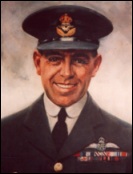Solent Sky magazine – Summer 2004
In a quiet country churchyard at Fawley, a stone’s throw from the Solent, lies one of the quieter heroes of the First World War – a conflict in which a select few were lionised. He is Samuel Kinkead who, though only a Flight Lieutenant when he was killed off Calshot at the age of 31, was recognised as one of the finest pilots in the Royal Air Force.
During the First World War he served initially in the Dardanelles and then, with No 1 Squadron RNAS (later 201 Squadron RAF), on the Western Front. He is credited with the destruction of at least 30 enemy aircraft in those theatres, six times the total required to be classified as an “ace”. By the end of the Great War he had won the Distinguished Service Cross twice and the Distinguished Flying Cross twice.
More than 30 years after his death in 1928, an American, Marion Aten, who had flown with “Kink” Kinkead on his next campaign, co-wrote a book about it entitled Last Train Over Rostov Bridge. The lapse of time may have clouded some of the details, but the picture of the young officer in command of B Flight, 47 Squadron RAF in Russia, still strikes the reader as vivid and authentic.
This was the most controversial part of Kink’s career: Churchill’s crusade to overturn the Russian revolution and “strangle Bolshevism at birth”. The chaos and cruelty are hauntingly portrayed in Aten’s book, though curiously the incredible feat that won Kinkead his immediate DSO in the field is not clearly set out.
The war diary and other records of 47 Squadron reveal what happened: leading a flight of four Sopwith Camels, Kink flew to within ten feet of the ground and took on 4,000 charging Red cavalrymen. This action drove an entire Bolshevik division from the field of battle with great loss, saving the city of Tsaritsyn (later to become famous as Stalingrad) from being overrun. Although his engine was shot through, he made it back to his special flight train; had he not, his story would have ended nine years earlier than it did.
After a period as an instructor at Cranwell, and then on active service in Iraq, where he greatly impressed the famous Welsh air ace Ira Jones, who had flown with the legendary “Mick” Mannock VC on the Western Front, Kink was chosen as one of three pilots for the RAF team in the 1927 Schneider Trophy contest. The team triumphed at Venice, but Kinkead was lucky to escape with his life when the propeller shaft of his Gloster biplane cracked in the closing stages of the race.
Undeterred he took charge of a reformed High Speed Flight early in 1928 in an attempt to become the first man to fly at more than five miles a minute. A trial run at Calshot on Sunday, March 11, was described by the local press as a brilliant flying display. Kink’s tiny S5 seaplane was said to have flashed across the Solent at such tremendous speed that the photographers could not capture the image.
The 300 mph barrier thus seemed within reach and it has been estimated that Kink was travelling at 330 mph the following day when the plane plunged into the water killing him instantly.
Suddenly, Great Britain realised that it had lost a remarkable young man. The Times devoted its leading article to him. The Secretary of State for Air told the House of Commons that, had he lived, he might well have reached the very top of the Royal Air Force.
Ire Jones described him as “without doubt” the RAF’s “finest junior officer”, and years later, his tragic death was lamented in The First of the Few, the classic film about R. J. Mitchell and the birth of the Spitfire, to which Kinkead and other S5 and S6 pilots had contributed so much.
Today he is still honoured on the Waterside area close to Southampton Water. More than 330 people attended a special service at Fawley church in 1998 on the 70th anniversary of his death when the RAF mounted a Tornado fighter fly-past for the occasion.
The Kinkead Trophy is still awarded every year at Cranwell; and the main conference room in the hangar from which he flew at Calshot is named after him and houses a collection of memorabilia.
Had he lived, he might have become, like several of his fellow Schneider Trophy pilots, a very senior RAF officer; but the legacy of his character and actual achievements more than make up for those that fate decided would remain unfulfilled.
[For more information on Samuel Kinkead, click here.]
[Julian's biography of Samuel Kinkead, RACING ACE, was published in March 2011. For full details, click here and here.]
